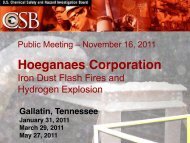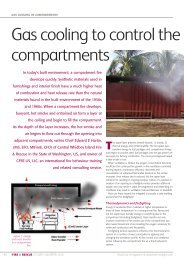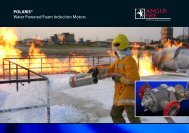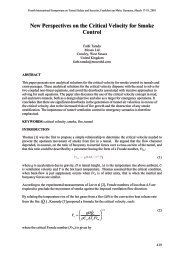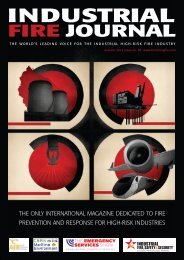Evacuation in Complex Environments - Industrial Fire Journal
Evacuation in Complex Environments - Industrial Fire Journal
Evacuation in Complex Environments - Industrial Fire Journal
Create successful ePaper yourself
Turn your PDF publications into a flip-book with our unique Google optimized e-Paper software.
Fourth International Symposium on Tunnel Safety and Security, Frankfurt am Ma<strong>in</strong>, Germany, March 17-19, 2010<br />
<strong>Evacuation</strong> <strong>in</strong> <strong>Complex</strong> <strong>Environments</strong> - An Analysis of<br />
<strong>Evacuation</strong> Conditions at a Tunnel Construction Site<br />
Håkan Frantzich & Daniel Nilsson<br />
Department of <strong>Fire</strong> Safety Eng<strong>in</strong>eer<strong>in</strong>g and Systems Safety, Lund University, Sweden<br />
ABSTRACT<br />
Experiments have shown that the evacuation characteristics <strong>in</strong> complex environments differ<br />
significantly from evacuation <strong>in</strong> public build<strong>in</strong>gs. This has to do with, for example, the necessity to<br />
move along paths that may not be optimal for evacuation, i.e., movement on ladders and through<br />
narrow passages. In some cases, protective cloth<strong>in</strong>g has to be removed before evacuation can be<br />
<strong>in</strong>itiated, which means that the pre-movement time can be quite long. Another difference compared to<br />
public build<strong>in</strong>g evacuations is that the attitudes among the workers towards fire safety education and<br />
safety drills is sometimes very negative. Results from an evacuation experiment from an environment<br />
identified as complex are presented; evacuation from a tunnel bor<strong>in</strong>g mach<strong>in</strong>e (TBM) where refuge<br />
chambers were used. In addition, some prelim<strong>in</strong>ary modell<strong>in</strong>g results are presented for the tunnel <strong>in</strong><br />
question. The paper will focus on evacuation <strong>in</strong> complex environments and, more specifically, it will<br />
attempt to<br />
- identify movement characteristics for people <strong>in</strong> complex environments,<br />
- discuss technical measures that can improve evacuation, and<br />
- suggest management procedures that can improve evacuation<br />
KEYWORDS: tunnel, evacuation, construction site, fire<br />
INTRODUCTION<br />
By tradition most evacuation analyses have focused on the problems associated with evacuation of<br />
large populations <strong>in</strong> public environments. This is partly due to the need for build<strong>in</strong>g codes to<br />
rationally regulate evacuation capacity of doorways, corridors and stairways etc. Another reason for<br />
<strong>in</strong>vestigat<strong>in</strong>g the evacuation capacity for large populations is the need to f<strong>in</strong>d <strong>in</strong>put data for egress<br />
modell<strong>in</strong>g for large crowds. This has also lead to the development of several egress models, which are<br />
suited for handl<strong>in</strong>g large populations. The typical premises for these models are public build<strong>in</strong>gs, e.g.,<br />
sports arenas, mass transit systems and high rise build<strong>in</strong>gs. Much attention has also been focused on<br />
places where people may not be able to evacuate by themselves, e.g., total <strong>in</strong>stitutions [1], or<br />
build<strong>in</strong>gs where people may not be familiar with the layout and evacuation routes, e.g., retail stores<br />
[2, 3]. <strong>Evacuation</strong> <strong>in</strong> these types of environments is therefore rather well documented.<br />
However, knowledge about evacuation <strong>in</strong> <strong>in</strong>dustrial premises and at construction sites is relatively<br />
limited. <strong>Evacuation</strong> conditions for people that work <strong>in</strong> <strong>in</strong>dustrial premises or at construction sites<br />
could be very different from the conditions that can be expected <strong>in</strong> public build<strong>in</strong>gs. Experiences from<br />
fires <strong>in</strong> such occupancies reveal major difficulties dur<strong>in</strong>g fires and evacuation e.g. the fire <strong>in</strong> Store<br />
Baelt rail tunnel construction <strong>in</strong> 1994 [4]. Most importantly, the environments are sometimes very<br />
complex, i.e., difficult to evacuate due to both cognitive and physical obstacles. For example, a<br />
construction site is constantly chang<strong>in</strong>g, which means that the evacuation routes can be modified from<br />
one day to another and may not always be clearly marked. This type of constant modification can<br />
make way-f<strong>in</strong>d<strong>in</strong>g problematic. At many construction sites and <strong>in</strong>dustrial premises people also have to<br />
181
Fourth International Symposium on Tunnel Safety and Security, Frankfurt am Ma<strong>in</strong>, Germany, March 17-19, 2010<br />
evacuate through narrow passages or down ladders, which means that there is an apparent risk of<br />
<strong>in</strong>jury. The environmental conditions may also impose other difficulties such as problems hear<strong>in</strong>g an<br />
evacuation alarm because of background noise and problem mov<strong>in</strong>g to a place of safety due to narrow<br />
passages and obstacles <strong>in</strong> the path of travel. These types of factors make the environment complex<br />
with regards to fire evacuation which can form extra hazards that have to be dealt with dur<strong>in</strong>g<br />
operation <strong>in</strong> the complex spaces.<br />
Much of the preventive work safety relies on traditional procedures and not much work has been<br />
published focus<strong>in</strong>g on the special problems fac<strong>in</strong>g workers dur<strong>in</strong>g evacuation from these complex<br />
environments. Special attention has therefore been made to <strong>in</strong>vestigate the special conditions that may<br />
be present for these environments.<br />
The nature of the problems <strong>in</strong> the complex environments are similar to those <strong>in</strong> traditional assembly<br />
type build<strong>in</strong>gs, i.e. there are problems gett<strong>in</strong>g aware of the fire threat, the cues related to fires have to<br />
be <strong>in</strong>terpreted and a decision mak<strong>in</strong>g process has to be <strong>in</strong>itiated and f<strong>in</strong>ally there is a movement<br />
distance between the location of the people and a safe place. Obviously, there are differences which<br />
are related to the <strong>in</strong>creased complexity of the environment. Some aspects that may <strong>in</strong>crease the<br />
complexity are:<br />
- Visual access – limited visual overview, dim light<strong>in</strong>g, darkness, etc<br />
- Sound level – noisy environments, background noise, etc<br />
- Familiarity – unfamiliar environment, constantly chang<strong>in</strong>g environment, etc<br />
- Obstacles and narrow passages – manholes, drops, etc<br />
- Difficult passages or bottle-necks – ladders, remote locations (e.g. cranes), airlocks, etc<br />
- Work that needs to be term<strong>in</strong>ated properly due to safety reasons – weld<strong>in</strong>g, crane operation,<br />
etc<br />
- Isolated environment – long distance to a safe location, low visual access to the surround<strong>in</strong>gs<br />
etc.<br />
In order to demonstrate some of the factors <strong>in</strong>fluenc<strong>in</strong>g the evacuation conditions present <strong>in</strong> the<br />
complex environments an evacuation experiment was performed <strong>in</strong> a tunnel bor<strong>in</strong>g mach<strong>in</strong>e (TBM)<br />
used for construct<strong>in</strong>g a railway tunnel <strong>in</strong> Sweden. The TBM, which is over 240 m long and has a<br />
diameter of over 10 metres, has currently proceeded approximately 5 kilometres <strong>in</strong>to the mounta<strong>in</strong>.<br />
The typical problems for this scenario are that there is only one escape route, the noise level is high<br />
and it is difficult to have visual access of the environment.<br />
The safety for the tunnel workers has also been <strong>in</strong>vestigated us<strong>in</strong>g a simple one-dimensional<br />
evacuation model. The model determ<strong>in</strong>es the possibility for cont<strong>in</strong>uous evacuation for persons <strong>in</strong> a<br />
tunnel given a prescribed fire development. It is necessary for the tunnel construction operator to<br />
<strong>in</strong>vestigate different fire scenarios that can occur as perform<strong>in</strong>g experiments and drills can only<br />
capture some aspects of the possible outcome of an accident. Therefore modell<strong>in</strong>g and physical<br />
experiments have to complement each other to broader the picture and provide <strong>in</strong>put for additional<br />
safety assessment. The paper, therefore, <strong>in</strong>troduces a simple MATLAB model that can be used for an<br />
<strong>in</strong>itial sensitivity analysis of the evacuation situation for the tunnel workers.<br />
The evacuation research is part of the ongo<strong>in</strong>g research project “<strong>Fire</strong> safety <strong>in</strong> tunnels dur<strong>in</strong>g<br />
construction” which is supported by The Swedish Civil Cont<strong>in</strong>gencies Agency (MSB) and led by the<br />
Technical Research Institute of Sweden <strong>in</strong> Borås. The purpose for the ma<strong>in</strong> research project is to<br />
<strong>in</strong>vestigate the fire behaviour, the occupant evacuation conditions and the needs for a proper rescue<br />
operation <strong>in</strong> tunnels, which are under construction. The research project is runn<strong>in</strong>g to the end of 2010.<br />
This paper is based on a paper [5] presented at the 4 th International Symposium on Human Behaviour<br />
<strong>in</strong> <strong>Fire</strong>, 13-15 July 2009.<br />
182
Fourth International Symposium on Tunnel Safety and Security, Frankfurt am Ma<strong>in</strong>, Germany, March 17-19, 2010<br />
GENERAL CONDITIONS FOR THE EVACUATION EXPERIMENT<br />
The Tunnel Bor<strong>in</strong>g Mach<strong>in</strong>e (TBM), figure 1, is used at the Hallandsås rail tunnel site <strong>in</strong> southern<br />
Sweden. Two parallel tunnels will be constructed for <strong>in</strong>creas<strong>in</strong>g the rail capacity between several<br />
large cities <strong>in</strong> western Sweden. Accord<strong>in</strong>g to the latest <strong>in</strong>formation from Banverket, the Swedish Rail<br />
Adm<strong>in</strong>istration, the tunnel will be open for traffic <strong>in</strong> 2015. Currently the TBM is located <strong>in</strong> the<br />
mounta<strong>in</strong> <strong>in</strong> the first of the two tubes and at this stage the tunnell<strong>in</strong>g consortium wanted to test the<br />
evacuation and rescue procedures dur<strong>in</strong>g fires. An exercise was planned and executed to <strong>in</strong>vestigate<br />
the evacuation capacity, the responses by the workers <strong>in</strong> the tunnel and <strong>in</strong> the TBM. In addition<br />
<strong>in</strong>vestigations of movement patterns and walk<strong>in</strong>g speeds were also measured and other special<br />
conditions relevant for the construction site.<br />
Figure 1. Schematic figure of the TBM, side view. Total length approximately 240 m, drill head<br />
diameter 10,6 m.<br />
In case of an emergency the procedure for the tunnel workers is to move to a safe location <strong>in</strong>side the<br />
TBM, a refuge chamber <strong>in</strong> which the workers can stay dur<strong>in</strong>g a fire. The TBM has two refuge<br />
chambers, one fixed to the TBM and another that can drive away from the TBM along the tracks on<br />
the bottom of the constructed part of the tunnel, figure 2. The tracks are usually used for mov<strong>in</strong>g<br />
personnel and goods between the TBM and the outside. As the procedure for the workers is to stay <strong>in</strong><br />
the refuge chambers it was considered important to <strong>in</strong>vestigate the attitudes among the workers to see<br />
how they perceived their situation <strong>in</strong> case of a fire. Another issue of <strong>in</strong>terest was how communication<br />
between the workers was ma<strong>in</strong>ta<strong>in</strong>ed dur<strong>in</strong>g the emergency as people with different nationalities are<br />
among those present <strong>in</strong> the TBM. It was also assumed that movement paths should be documented <strong>in</strong><br />
order to better prepare for safer walk<strong>in</strong>g paths <strong>in</strong>side the TBM.<br />
Figure 2. Illustration of the mobile refuge chamber (to the left) and the permanently fixed refuge<br />
chamber <strong>in</strong>side the TBM.<br />
183
Fourth International Symposium on Tunnel Safety and Security, Frankfurt am Ma<strong>in</strong>, Germany, March 17-19, 2010<br />
The TBM is a more than 240 m long mov<strong>in</strong>g construction site with ma<strong>in</strong>ly two floors or decks. It is<br />
constructed of several so called trailers l<strong>in</strong>ked together <strong>in</strong> the tunnel. On the lower deck the<br />
ma<strong>in</strong>tenance tra<strong>in</strong> can enter to deliver goods and tunnel elements used to l<strong>in</strong>e the tunnel as it proceeds.<br />
The upper deck is ma<strong>in</strong>ly used for the mach<strong>in</strong>ery of the TBM, the personnel mess room and pilot<br />
cab<strong>in</strong> from which the TBM is operated. In the front end the huge excavation wheel (drill head) is<br />
located cutt<strong>in</strong>g the hole <strong>in</strong> the mounta<strong>in</strong>. The TBM is equipped with an automatic fire alarm which<br />
can be readily heard all over the TBM. The alarm uses an alternat<strong>in</strong>g tone signal. Detectors are<br />
located at extra hazardous places but not all over the mach<strong>in</strong>e. At places for storage of flammable<br />
liquids and hydraulic equipment fire ext<strong>in</strong>guish<strong>in</strong>g systems are located. There are also spr<strong>in</strong>kler<br />
curta<strong>in</strong>s <strong>in</strong> the TBM separat<strong>in</strong>g the mach<strong>in</strong>e <strong>in</strong>to three sections. <strong>Evacuation</strong> is supposed to be<br />
performed along one of the TBM sides on both decks. The decks are l<strong>in</strong>ked by stairs at several<br />
locations and it is rather easy to move between the decks. The escape routes are marked with<br />
traditional signs and equipped with emergency light<strong>in</strong>g. Dur<strong>in</strong>g normal operation approximately 20-<br />
25 persons operate the TBM and the highest allowed number <strong>in</strong> the tunnel is 40 persons set by the<br />
contractor.<br />
Participants<br />
The participants <strong>in</strong> the experiment were the normal crew on the TBM but they were work<strong>in</strong>g with<br />
ma<strong>in</strong>tenance tasks. This means that the number of participants <strong>in</strong> the TBM was about 24 and none of<br />
them were aware of the experiment, which mean that the evacuation was unannounced. The exact<br />
number of participants is not known but estimated by the number enter<strong>in</strong>g the refuge chambers (23<br />
persons entered the refuge chambers) dur<strong>in</strong>g the evacuation. The last participant, i.e. the TBM pilot,<br />
rema<strong>in</strong>ed at his work<strong>in</strong>g location as a safety precaution. He was told to stay <strong>in</strong> place by one of the<br />
observers at the start of the experiment. From the demographic part of the questionnaire it was found<br />
that all participants except one were men. The mean age was 39 years (between 27 and 56) and they<br />
came from different countries namely Sweden, Denmark, UK, France, Australia and Poland. All of<br />
them, except one, could communicate <strong>in</strong> English. All of them had previous experiences from fire<br />
drills and fire ext<strong>in</strong>guish<strong>in</strong>g tra<strong>in</strong><strong>in</strong>g. Two of the participants had previous experience from real tunnel<br />
fires and one of those experienced the fire <strong>in</strong> Store Baelt tunnel <strong>in</strong> Denmark <strong>in</strong> 1994 [4].<br />
In addition approximately five other persons were <strong>in</strong> the TBM as observers and safety officers <strong>in</strong> case<br />
the experiment had to be term<strong>in</strong>ated.<br />
Procedure<br />
The experiment was performed dur<strong>in</strong>g a period of normal ma<strong>in</strong>tenance on the TBM on 7 November<br />
2008. Before the experiment was started more than 25 video cameras were mounted at different<br />
locations <strong>in</strong> the TBM. The locations were chosen to have a good chance of observ<strong>in</strong>g <strong>in</strong>itial actions by<br />
the workers and also for observ<strong>in</strong>g chosen walk<strong>in</strong>g paths and measur<strong>in</strong>g walk<strong>in</strong>g speeds. The purpose<br />
was to measure walk<strong>in</strong>g speeds both on a horizontal surface and <strong>in</strong> stairs. In addition a number of<br />
cameras were located <strong>in</strong>side the two refuge chambers <strong>in</strong> order to be able to observe the behaviour of<br />
the participants when they have entered the chambers.<br />
The scenario for the experiment was that a fire had started <strong>in</strong> a ma<strong>in</strong>tenance tra<strong>in</strong> approximately 1 km<br />
beh<strong>in</strong>d the TBM. This means that there was no fire onboard the TBM and no smoke were present<br />
dur<strong>in</strong>g the experiment. But as the fire blocks the only escape route to the outside such a scenario is<br />
considered serious and an evacuation of the TBM shall always be performed <strong>in</strong> case of a fire <strong>in</strong> the<br />
tunnel. However, the actual threat to the workers on the TBM is not present but the uncerta<strong>in</strong>ty of the<br />
situation can cause an at least as important concern among the workers.<br />
The alarm to the TBM came from the outside to the pilot <strong>in</strong>form<strong>in</strong>g him about the fire <strong>in</strong> the tunnel.<br />
He <strong>in</strong>itiated the fire alarm <strong>in</strong> the TBM after some ambiguity about procedures. Accord<strong>in</strong>g to the<br />
normal procedure he shall then leave for the refuge chambers but due to safety reasons he stayed <strong>in</strong><br />
the pilot cab<strong>in</strong> after <strong>in</strong>structions by one of the observers.<br />
184
Fourth International Symposium on Tunnel Safety and Security, Frankfurt am Ma<strong>in</strong>, Germany, March 17-19, 2010<br />
At the time when the alarm was <strong>in</strong>itiated the workers were at different locations <strong>in</strong>side the TBM. Six<br />
persons were <strong>in</strong> the mess room, one at the drill head and two were work<strong>in</strong>g on the lower deck with<br />
some ma<strong>in</strong>tenance work. The locations of the other persons are not known <strong>in</strong> detail as they were<br />
outside the coverage areas of the video cameras. After the fire alarm was <strong>in</strong>itiated the evacuation to<br />
the refuge chambers started and the workers left their present locations.<br />
When the workers had been <strong>in</strong>side the refuge chambers for approximately 15 m<strong>in</strong>utes one of the<br />
observers entered the chambers and handed out questionnaires which were returned after completion.<br />
In total 20 questionnaires was returned and demographic questions were also <strong>in</strong>cluded <strong>in</strong> the<br />
questionnaire. After approximately 40 m<strong>in</strong>utes after the alarm was <strong>in</strong>itiated the experiment was<br />
term<strong>in</strong>ated and the workers returned to their previous tasks.<br />
Results<br />
Pre-movement time<br />
The responses by the participants were very swift. Those who were able to observe from the video<br />
cameras responded with<strong>in</strong> less than 30 seconds. At the drill<strong>in</strong>g head one person who was engaged<br />
with some work left his place only after four seconds after the alarm started. He was alone at the<br />
location.<br />
The persons sitt<strong>in</strong>g <strong>in</strong> the mess room also responded very quickly, i.e. only after 10 seconds after the<br />
alarm started. One person <strong>in</strong> the mess room was delayed for 30 seconds<br />
<strong>Fire</strong> alarm<br />
From the questionnaires it is evident that all the workers perceived the fire alarm. Most of them<br />
responded because they heard the fire alarm and understood that they should evacuate and move<br />
towards the refuge chambers. All of them responded with answers that associated the fire alarm signal<br />
to fire, evacuation, danger and other similar.<br />
Exit choice<br />
One of the factors to <strong>in</strong>vestigate was how the persons chose exit routes to the refuge chambers. In<br />
general all of the workers used the walk<strong>in</strong>g paths normally used to access the different parts of the<br />
TBM. This means that they used the paths along the right side of the TBM (seen from beh<strong>in</strong>d the<br />
TBM). As it is normally easier to walk on the lower deck many of the persons chose to climb down at<br />
the nearest stair of reach the lower deck. The refuge chambers are also located at the lower deck so<br />
this choice is probably also affected by this knowledge.<br />
Attitude<br />
One key element <strong>in</strong> determ<strong>in</strong><strong>in</strong>g exit behaviour from areas of complex environment is the attitude<br />
towards fire safety issues and evacuation exercises among the workers. The outcome of an evacuation<br />
is sometimes dependent on a rapid and correct response by the persons exposed to the fire threat.<br />
Therefore the questionnaire conta<strong>in</strong>ed a number of questions related to f<strong>in</strong>d <strong>in</strong>formation on how the<br />
workers thought about fire safety and similar. As the answers were assumed to differ between persons<br />
be<strong>in</strong>g together with colleagues, i.e. those who <strong>in</strong>itially were <strong>in</strong> the mess room or <strong>in</strong> the pilot cab<strong>in</strong> and<br />
those who were alone or be<strong>in</strong>g with just one other colleague, i.e. be<strong>in</strong>g at other locations <strong>in</strong> the TBM,<br />
those two groups were separated. The responses are presented <strong>in</strong> figure 3 giv<strong>in</strong>g the average values of<br />
the responses to each question <strong>in</strong> the questionnaire for the two groups and for all together. The<br />
numbers <strong>in</strong>dicate the degree to which the person disagrees to the statement. The scale range from 1<br />
which is “strongly agree” to 4 which corresponds to “strongly disagree”.<br />
185
Fourth International Symposium on Tunnel Safety and Security, Frankfurt am Ma<strong>in</strong>, Germany, March 17-19, 2010<br />
State to what extent you agree with the follow<strong>in</strong>g statements. 1="Strongly<br />
agree" amd 4="Strongly disagree"<br />
0 1 2 3 4 5<br />
a)<br />
b)<br />
all<br />
c)<br />
d)<br />
e)<br />
f)<br />
remote from TMB control<br />
cab<strong>in</strong> and mess room<br />
<strong>in</strong> TBM control cab<strong>in</strong> or<br />
mess room<br />
g)<br />
h)<br />
i)<br />
j)<br />
k)<br />
l)<br />
m)<br />
n)<br />
o)<br />
p)<br />
Figure 3. Questionnaire results from TBM evacuation. The statements are presented <strong>in</strong> table 1 below.<br />
186
Fourth International Symposium on Tunnel Safety and Security, Frankfurt am Ma<strong>in</strong>, Germany, March 17-19, 2010<br />
Table 1. Questionnaire statements for the experiment <strong>in</strong> Hallandsås tunnel.<br />
Statements<br />
a) I thought there was a fire when I heard the alarm.<br />
b) <strong>Evacuation</strong> drills are unnecessary.<br />
c) I thought it was a drill when I heard the alarm.<br />
d) <strong>Evacuation</strong> drills take unnecessary much time to perform.<br />
e) I thought an accident had occurred when I heard the alarm.<br />
f) I thought someth<strong>in</strong>g wrong with the TBM when I heard the alarm.<br />
g) <strong>Fire</strong> drills take unnecessary much time to perform.<br />
h) Tid<strong>in</strong>ess is necessary for fire safety.<br />
i) I thought the tunnel had caved <strong>in</strong> when I heard the alarm.<br />
j) I thought there was some electrical failure when I heard the alarm.<br />
k) Signs (se below) <strong>in</strong>dicat<strong>in</strong>g the routes to the refuge chamber are not necessary.<br />
l) I thought someth<strong>in</strong>g was wrong with the alarm when I heard the alarm.<br />
m) I thought it was a false alarm when I heard the alarm.<br />
n) <strong>Evacuation</strong> drills are necessary.<br />
o) I thought someth<strong>in</strong>g serious had happened when I heard the alarm.<br />
p) <strong>Evacuation</strong> drills are a good way to practice.<br />
It is clear from the answers that persons be<strong>in</strong>g alone or together with just one colleague were more<br />
uncerta<strong>in</strong> about the situation than those who were sitt<strong>in</strong>g <strong>in</strong> for example the mess room. Persons be<strong>in</strong>g<br />
at other locations than the mess room and pilot cab<strong>in</strong> did to a higher degree associate the alarm signal<br />
to fire and emergency, cf. statements a) and c). People sitt<strong>in</strong>g together <strong>in</strong> the mess room could agree<br />
more rapidly that this is probably an exercise and not a real fire.<br />
Other statements resulted <strong>in</strong> more similar answers, i.e. were not depend<strong>in</strong>g on the location of the<br />
participants and who they were together with. Notably is that all of the participants agree that tid<strong>in</strong>ess<br />
is important and that safety procedures are important <strong>in</strong> order to keep a high level of fire safety.<br />
Walk<strong>in</strong>g speed<br />
The walk<strong>in</strong>g speed for the participant was rather fast at the po<strong>in</strong>t where speed was measured. In the<br />
stair the speed varied between 0,75 m/s and 1,0 m/s measured along the slope. The walk<strong>in</strong>g speed<br />
along a horizontal surface was naturally higher and ranged between 1,0 m/s and 1,7 m/s. The data<br />
po<strong>in</strong>ts for the lower value <strong>in</strong>cluded also some vertical movement as the participants jumped from a<br />
walk<strong>in</strong>g path along the TBM to the lower deck, a distance of approximately 0,8 m. This means that<br />
the average speed between two measur<strong>in</strong>g po<strong>in</strong>ts was lower than the actual local walk<strong>in</strong>g speed but<br />
the difference at the po<strong>in</strong>t of measur<strong>in</strong>g cannot be determ<strong>in</strong>ed. The walk<strong>in</strong>g speed at another<br />
measur<strong>in</strong>g po<strong>in</strong>t showed higher values, up to 1,7 m/s. The variation was low as most of the<br />
participants moved together <strong>in</strong> groups with almost the same speed.<br />
<strong>Evacuation</strong> time and general observations<br />
In total the evacuation took approximately 3 m<strong>in</strong>utes to perform from the time when the fire alarm<br />
started to all participants were <strong>in</strong>side one of the refuge chambers. The first participants arrived to the<br />
refuge chambers approximately 1 m<strong>in</strong>ute from the start of the fire alarm. The first ones to arrive<br />
started to prepare the mobile refuge chamber for the case they had to abandon the TBM and drive out<br />
of the tunnel. After this they entered the mobile refuge chamber.<br />
187
Fourth International Symposium on Tunnel Safety and Security, Frankfurt am Ma<strong>in</strong>, Germany, March 17-19, 2010<br />
A comment from the participants dur<strong>in</strong>g discussions after the experiment revealed that<br />
communication between the participants on the TBM and between the participants on the TBM and<br />
persons outside the tunnel did not work properly. Communications over the radio dur<strong>in</strong>g the<br />
experiment was sometimes <strong>in</strong> Swedish, which made it difficult for participants not understand<strong>in</strong>g<br />
Swedish to follow the conversation. The formal procedure is that all communication shall be <strong>in</strong><br />
English.<br />
The participants also mentioned that there was a lack of <strong>in</strong>formation regard<strong>in</strong>g the situation from<br />
persons outside the tunnel. As there was no clear sign of a fire at the TBM the situation was rather<br />
ambiguous for the participants when they were sitt<strong>in</strong>g <strong>in</strong> the refuge chambers. One person also<br />
mentioned that he was anxious that someone had not noticed the fire alarm and still be at a place <strong>in</strong><br />
the TBM. The <strong>in</strong>formation about the exact number of persons on the TBM dur<strong>in</strong>g the experiment was<br />
uncerta<strong>in</strong> to the persons supposed to be the only ones at the mach<strong>in</strong>e.<br />
EVACUATION MODELLING<br />
The evacuation model used for <strong>in</strong>vestigat<strong>in</strong>g the possibility for tunnel workers to safely evacuate a<br />
tunnel compares the time for evacuation with the time for untenable conditions to occur. The model is<br />
based on a one-dimensional approach of smoke spread <strong>in</strong> the tunnel. This means that the smoke<br />
temperature, gas concentrations, visibility etc only depend of the distance from the fire and the time.<br />
The vertical variation is ignored and it is assumed that homogenous conditions apply, which is true at<br />
a distance from the fire. Close to the fire the model will provide a not so good prediction of the<br />
conditions.<br />
The smoke spread and subsequently the spread of toxic gases, temperature etc are calculated us<strong>in</strong>g the<br />
model provided by Ingason [6] and only need to have a HRR curve as an <strong>in</strong>put. It is assumed that the<br />
fire is located <strong>in</strong> the most remote part of the tunnel construction site, i.e. where the actual tunnel is<br />
excavated.<br />
The evacuation model is based on the assumption that a person cont<strong>in</strong>ues to move away from a fire,<br />
after an <strong>in</strong>itial pre-movement time, at a speed that depends on the smoke conditions, i.e. the visibility.<br />
Reduction <strong>in</strong> visibility reduces the walk<strong>in</strong>g speed. The person can <strong>in</strong>itially already be at a distance<br />
away from the fire. The movement cont<strong>in</strong>ues as long as the person is conscious and that depends on<br />
the accumulated toxic dose of the smoke gases, ma<strong>in</strong>ly carbon monoxide, carbon dioxide, low oxygen<br />
concentration and elevated temperature. The toxic accumulation is derived us<strong>in</strong>g the Fractional<br />
Effective Dose theory proposed by Purser [7]. It is assumed that unconsciousness occur when the<br />
person has accumulated a toxic dose equivalent to FED = 1,0.<br />
A prelim<strong>in</strong>ary analysis was made on the Hallandsås rail tunnel us<strong>in</strong>g a 30 MW fire as the first<br />
assumption. The fire peaks at 30 MW at approximately 13 m<strong>in</strong>utes from the fire start. The ventilation<br />
air supply to the construction site is assumed to result <strong>in</strong> a supply air velocity of 0,5 m/s across the<br />
tunnel section.<br />
Some of the results from this <strong>in</strong>itial analysis are presented <strong>in</strong> table 2 which show whether or not<br />
evacuation is possible and how far from the fire a safe refuge must be located.<br />
Table 2. Basic results from the sample analysis.<br />
Scenario Pre-movement<br />
time, sec<br />
Initial distance between<br />
person and fire, m<br />
Distance when FED<br />
= 1,0 occurs, m<br />
Time when FED =<br />
1,0 occurs, m<strong>in</strong>utes<br />
1 60 0 - never<br />
2 120 0 250 22<br />
3 120 50 - never<br />
4 120 30 - never<br />
5 150 30 300 25<br />
188
Fourth International Symposium on Tunnel Safety and Security, Frankfurt am Ma<strong>in</strong>, Germany, March 17-19, 2010<br />
From analys<strong>in</strong>g the different scenarios it is evident that as long as the evacuation can be <strong>in</strong>itiated with<br />
only a small delay most of the occupants <strong>in</strong> the tunnel can evacuate safely. But if they respond slowly<br />
or are close to the fire so they already are with<strong>in</strong> a smoky section they will have difficulties to escape.<br />
One shall, though, be aware of that <strong>in</strong> this case the fire is rather large and only a small part of the<br />
analysis is presented. But the purpose with these results is to demonstrate that it is quite easy to<br />
perform an evacuation analysis of the tunnel construction site <strong>in</strong> order to get an idea of the fire threat.<br />
Additional analyses, for example regard<strong>in</strong>g heat radiation on the workers, have to be performed to get<br />
a broader picture of the workers’ safety.<br />
DISCUSSION<br />
Evacuat<strong>in</strong>g from a complex environment can be difficult to perform without any additional<br />
improvements of the environment or additional <strong>in</strong>formation or education of the persons subjected to<br />
the environment. The experiment shows that the outcome of an evacuation can depend on the attitudes<br />
among the persons <strong>in</strong> the environment even if that factor is not part of the environment but rather as<br />
an external factor associated to how the environment is used.<br />
However, given the conditions the overall impression is that the evacuation was prompt and efficient.<br />
The response time was very short for most of the participants <strong>in</strong>dicat<strong>in</strong>g that they were tra<strong>in</strong>ed to<br />
handle the situation. The attitudes regard<strong>in</strong>g safety <strong>in</strong> the case of a fire among the participants given<br />
from the questionnaires showed that they were aware of the seriousness if the situation was for real.<br />
Work<strong>in</strong>g <strong>in</strong> build<strong>in</strong>g sites, <strong>in</strong>dustries etc may need to use different equipment, cranes or mach<strong>in</strong>ery<br />
that cannot be shut down immediately at the time the fire alarm starts. Because of safety reasons some<br />
equipment need a shutt<strong>in</strong>g down period before it is safe to leave the work place. There is no simple<br />
solution for handl<strong>in</strong>g these problems but care has to be taken to prepare for emergency closure<br />
procedures of such equipment. Ma<strong>in</strong>ly this is a management procedure and the first priority <strong>in</strong> the<br />
case where the fire alarm starts must be to shut down the equipment <strong>in</strong>stead of question<strong>in</strong>g the reason<br />
for the alarm. This problem was not tested <strong>in</strong> a fully realistic manner as the TBM was shut down for<br />
ma<strong>in</strong>tenance and only runn<strong>in</strong>g <strong>in</strong> stand by mode. Some traditional ma<strong>in</strong>tenance work provided some<br />
<strong>in</strong>sights <strong>in</strong>to the problem.<br />
A quick response will most likely require a clear and understandable signal that can be readily heard<br />
from all relevant locations. The fire alarm <strong>in</strong> the TBM was possible to be heard from all locations <strong>in</strong><br />
the mach<strong>in</strong>e which contributed to the fast response. This is most important for cases when visual<br />
access is limited which usually is the situation for these locations as it def<strong>in</strong>es the complex<br />
environment. The use of fire alarm is therefore essential. The evacuation from the TBM clearly shows<br />
the need to use a fire alarm as this was the first sign of an unusual condition <strong>in</strong> the tunnel.<br />
Initially it was assumed that the walk<strong>in</strong>g speed should be lower than what can be expected <strong>in</strong> other<br />
occupancies. But this turned out to be wrong. In the TBM the participants walked at least as fast as<br />
shoppers <strong>in</strong> a warehouse even if the walk<strong>in</strong>g paths were not as smooth as <strong>in</strong> the warehouse. The<br />
reason for this could be that most of the persons, mostly men, work<strong>in</strong>g <strong>in</strong> this type of environment are<br />
rather strong and well fit for the job. It must be assumed that they are slightly better suited for mov<strong>in</strong>g<br />
<strong>in</strong> the narrow passages and along uneven surfaces. In most cases it can also be assumed that the<br />
persons are familiar to the environment at least after spend<strong>in</strong>g some time <strong>in</strong>, for this case, the TBM.<br />
However, <strong>in</strong> many other complex environments narrow passages may still be a problem even if the<br />
persons are familiar with the conditions. Climb<strong>in</strong>g a ladder through a narrow hole <strong>in</strong> a floor is much<br />
more difficult that us<strong>in</strong>g a stair. Elim<strong>in</strong>ation of difficult passages should therefore be considered if<br />
possible.<br />
189
Fourth International Symposium on Tunnel Safety and Security, Frankfurt am Ma<strong>in</strong>, Germany, March 17-19, 2010<br />
CONCLUSIONS<br />
The ma<strong>in</strong> conclusions of the present study are:<br />
- In complex environments it is necessary to use well designed fire alarms <strong>in</strong> order to reach all<br />
persons with proper <strong>in</strong>formation. If possible the fire alarm should be a spoken message.<br />
- Signage <strong>in</strong>dicat<strong>in</strong>g escape routes must be clearly visible even if the light <strong>in</strong> the environment is<br />
poor or uses a special colour.<br />
- Persons work<strong>in</strong>g <strong>in</strong> complex environments must be subjected to repeatedly evacuation<br />
exercises so they become with the familiarity with the situation. A fire <strong>in</strong> a complex<br />
environment is usually regarded more hazardous than others due to the complexity.<br />
- The comb<strong>in</strong>ation of exercises (experiments) and modell<strong>in</strong>g is necessary for hav<strong>in</strong>g a full<br />
understand<strong>in</strong>g of the difficulties dur<strong>in</strong>g a fire <strong>in</strong> a tunnel dur<strong>in</strong>g construction.<br />
REFERENCES<br />
1. Moss Haber, G. “Human behaviour <strong>in</strong> fire <strong>in</strong> total <strong>in</strong>stitutions; A case study”. In D. Canter<br />
(Ed.), <strong>Fire</strong>s and Human Behaviour (pp. 137-154). John Wiley & Sons Ltd, Chichester, 1980.<br />
2. Shields, T. J., & Boyce, K. E. “A study of evacuation from large retail stores”. <strong>Fire</strong> Safety<br />
<strong>Journal</strong>, 35(1), 25-49, 2000.<br />
3. Frantzich, H. “Occupant Behaviour and Response Time – Results from <strong>Evacuation</strong><br />
Experiments”. Proceed<strong>in</strong>gs of the 2nd International Symposium on Human Behaviour <strong>in</strong> <strong>Fire</strong>,<br />
pp 159-165, 2001.<br />
4. Tait, J., C., Høj N., P. “Storebælt eastern railway tunnel: Dania tunnel bor<strong>in</strong>g mach<strong>in</strong>e fire -<br />
analysis and recovery”. Supplement to Civil Eng<strong>in</strong>eer<strong>in</strong>g 114, special issue 1, Storebælt<br />
Eastern Railway Tunnel, 1996.<br />
5. Frantzich, H. & Nilsson, D. “<strong>Evacuation</strong> In <strong>Complex</strong> <strong>Environments</strong> - An Analysis Of<br />
<strong>Evacuation</strong> Conditions In a Nuclear Power Plant and A Tunnel Construction Site”.<br />
Proceed<strong>in</strong>gs of the 4th Int. Symp. on Human Behaviour <strong>in</strong> <strong>Fire</strong>, Rob<strong>in</strong>son College,<br />
Cambridge, UK, pp 207-218, 13-15 July 2009.<br />
6. Ingason, H. “<strong>Fire</strong> dynamics <strong>in</strong> tunnels”. In A. Beard and R. Carvel (Eds.) The handbook of<br />
tunnel fire safety (pp. 231-266). Thomas Telford Publ., London, 2005.<br />
7. Purser, D. “Assessment of Hazards to Occupants from Smoke, Toxic Gases and Heat”. In P.J.<br />
DiNenno et al. (Eds.) The SFPE Handbook of <strong>Fire</strong> Protection Eng<strong>in</strong>eer<strong>in</strong>g, 4th ed. National<br />
<strong>Fire</strong> Protection Association, Qu<strong>in</strong>cy, 2008.<br />
190


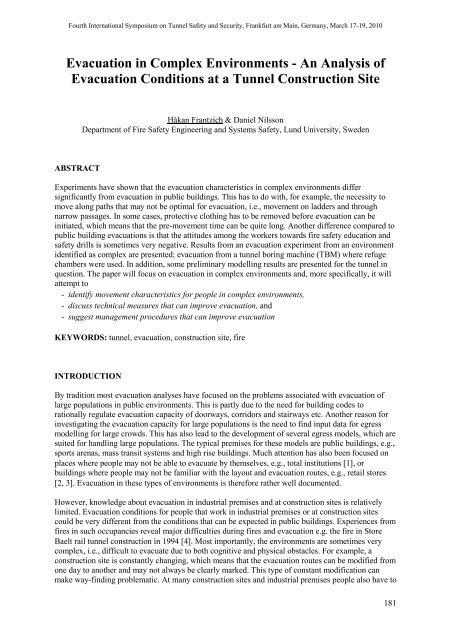
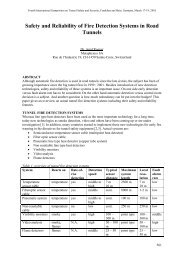

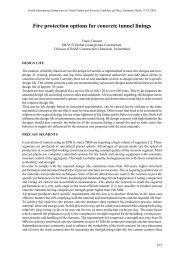
![30-37 TunnelsREV[1]rev.qxd - Industrial Fire Journal](https://img.yumpu.com/22237435/1/184x260/30-37-tunnelsrev1revqxd-industrial-fire-journal.jpg?quality=85)
